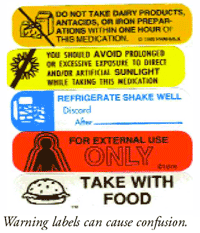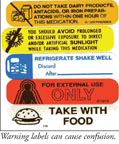Matthew Grissinger, RPh, FISMP, FASCP
Director, Error Reporting Programs
Institute for Safe Medication Practices
Horsham, Pennsylvania
Susan Proulx, PharmD
President, Med-E.R.R.S.
Institute for Safe Medication Practices
Horsham, Pennsylvania
2/20/2009
US Pharm. 2009;34(2):Epub.
Prescription drug warning labels (PWLs) are applied to prescription vials to provide patients with important instructions for the safe use of medications. Unfortunately, pharmacists may rely on these labels as the primary means of communicating crucial warning statements to patients; however, this practice can be unsafe if the patient is unable to understand the warning. A recent study showed that there is a high level of misunderstanding of PWLs among adults with low literacy levels.1
Label Comprehension: Eight different PWLs were used in this study (see examples). The rate of correct interpretation of these warnings ranged from 0% to 78.7%. With the exception of “Take with food,” less than half of all patients were able to provide adequate interpretations of the warning labels’ messages. Problems associated with text, icons, and color contributed to patients’ confusion. The findings indicated that some PWLs may inadvertently promote a misunderstanding of safety information, which could potentially lead to hazardous administration of the drug and adverse events.


Multiple-Step Instructions: Rates of comprehension were the lowest for PWLs with multiple steps. Respondents frequently were confused and unable to complete each step (e.g., “Refrigerate, shake well, discard after [date]”).
Reading Difficulty: Two PWLs included in the study were written at a high school or higher reading level and subsequently had the lowest comprehension rates (“You should avoid prolonged or excessive exposure to direct and/or artificial sunlight while taking this medication” and “Do not take dairy products, antacids, or iron preparations within one hour of this medication”). “Take with food” was written below a first-grade level and had the highest comprehension.
Message Clarity: Regardless of reading level, text on certain PWLs was not understood by most patients. For example, “For external use only,” which was written at a first-grade level, proved difficult for 90.7% of respondents to understand. For others, it was apparent that only part of the message could be interpreted. “Do not chew or crush, swallow whole” was misinterpreted as “do not swallow whole” or “chew it up so it will dissolve,” suggesting patients had read some, but not all, of the words on the label.
Icons or Symbols: Adults with low literacy may rely more heavily on symbols to interpret the meaning of labels. However, many of the icons used appeared to confuse patients, especially on labels with text that was difficult to comprehend. For example, the icon on “For external use only” was misinterpreted as “radioactive,” “chills or shaking,” or “take anywhere.”
Label Color: Approximately 42% of the patients correlated the label’s color to the severity of the message. Patients reported that a red label meant danger, yellow translated to caution, and blue, white, and green labels were viewed as “recommendations” that were not as critical as the instructions on red labels.
Safe Practice Recommendations: This study illustrates the importance of providing counseling to patients. Relying on the PWLs used on prescription vials is not enough. Other studies have shown that a combination of a verbal description and a visual symbol improves the overall comprehension of the warning.2 Evaluate the clarity of the wording and the symbols used before purchasing PWLs, and be selective about which ones you apply to prescription vials. Establish a process to consistently place only relevant PWLs on vials and to provide verbal instructions to patients.